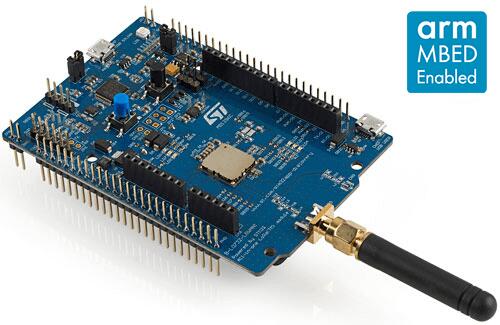ST B-L072Z-LRWAN1 Discovery kit
Overview
This Discovery kit features an all-in-one open module CMWX1ZZABZ-091 (by Murata). The module is powered by an STM32L072CZ and an SX1276 transceiver.
This kit provides:
CMWX1ZZABZ-091 LoRa* / Sigfox* module (Murata)
Embedded ultra-low-power STM32L072CZ Series MCUs, based on Arm* Cortex* -M0+ core, with 192 Kbytes of Flash memory, 20 Kbytes of RAM, 6 Kbytes of EEPROM
Frequency range: 860 MHz - 930 MHz
USB 2.0 FS
4-channel,12-bit ADC, 2xDAC
6-bit timers, LP-UART, I2C and SPI
Embedded SX1276 transceiver
LoRa* , FSK, GFSK, MSK, GMSK and OOK modulations (+ Sigfox* compatibility)
+14 dBm or +20 dBm selectable output power
157 dB maximum link budget
Programmable bit rate up to 300 kbit/s
High sensitivity: down to -137 dBm
Bullet-proof front end: IIP3 = -12.5 dBm
89 dB blocking immunity
Low Rx current of 10 mA, 200 nA register retention
Fully integrated synthesizer with a resolution of 61 Hz
Built-in bit synchronizer for clock recovery
Sync word recognition
Preamble detection
127 dB+ dynamic range RSSI
SMA and U.FL RF interface connectors
Including 50 ohm SMA RF antenna
On-board ST-LINK/V2-1 supporting USB re-enumeration capability
USB ST-LINK functions:
Board power supply:
Through USB bus or external VIN/3.3 V supply voltage or batteries
3xAAA-type-battery holder for standalone operation
7 LEDs:
4 general-purpose LEDs
A 5 V-power LED
An ST-LINK-communication LED
A fault-power LED
2 push-buttons (user and reset)
Arduino* Uno V3 connectors

More information about the board can be found at the B-L072Z-LRWAN1 website.
Hardware
The STM32L072CZ SoC provides the following hardware IPs:
Ultra-low-power (down to 0.29 µA Standby mode and 93 uA/MHz run mode)
Core: ARM* 32-bit Cortex*-M0+ CPU, frequency up to 32 MHz
Clock Sources:
1 to 32 MHz crystal oscillator
32 kHz crystal oscillator for RTC (LSE)
Internal 16 MHz factory-trimmed RC ( ±1%)
Internal low-power 37 kHz RC ( ±5%)
Internal multispeed low-power 65 kHz to 4.2 MHz RC
RTC with HW calendar, alarms and calibration
Up to 24 capacitive sensing channels: support touchkey, linear and rotary touch sensors
11x timers:
2x 16-bit with up to 4 channels
2x 16-bit with up to 2 channels
1x 16-bit ultra-low-power timer
1x SysTick
1x RTC
2x 16-bit basic for DAC
2x watchdogs (independent/window)
Up to 84 fast I/Os, most 5 V-tolerant.
Memories
Up to 192 KB Flash, 2 banks read-while-write, proprietary code readout protection
Up to 20 KB of SRAM
External memory interface for static memories supporting SRAM, PSRAM, NOR and NAND memories
Rich analog peripherals (independent supply)
1x 12-bit ADC 1.14 MSPS
2x 12-bit DAC
2x ultra-low-power comparators
11x communication interfaces
USB 2.0 full-speed device, LPM and BCD
3x I2C FM+(1 Mbit/s), SMBus/PMBus
4x USARTs (ISO 7816, LIN, IrDA, modem)
6x SPIs (4x SPIs with the Quad SPI)
7-channel DMA controller
True random number generator
CRC calculation unit, 96-bit unique ID
Development support: serial wire debug (SWD), JTAG, Embedded Trace Macrocell*
More information about STM32L072CZ can be found here:
Supported Features
The Zephyr B-L072Z-LRWAN1 Discovery board configuration supports the following hardware features:
Interface |
Controller |
Driver/Component |
|---|---|---|
UART |
on-chip |
serial port-polling; serial port-interrupt |
PINMUX |
on-chip |
pinmux |
I2C |
on-chip |
i2c |
SPI |
on-chip |
spi |
GPIO |
on-chip |
gpio |
RTC |
on-chip |
counter |
TRNG |
on-chip |
true random number generator |
EEPROM |
on-chip |
eeprom |
USB |
on-chip |
usb |
FLASH |
on-chip |
flash |
LoRa |
on-module |
sx1276 |
Other hardware features are not yet supported on this Zephyr port.
The default configuration can be found in the defconfig file: boards/st/b_l072z_lrwan1/b_l072z_lrwan1_defconfig
Connections and IOs
B-L072Z-LRWAN1 Discovery kit has GPIO controllers. These controllers are responsible for pin muxing, input/output, pull-up, etc.
Available pins:
For detailed information about available pins please refer to B-L072Z-LRWAN1 website.
Default Zephyr Peripheral Mapping:
UART_1_TX/RX: PA9/PA10 (Arduino Serial)
UART_2_TX/RX: PA2/PA3 (ST-Link Virtual COM Port)
SPI1 NSS/SCK/MISO/MOSI: PA15/PB3/PA6/PA7 (Semtech SX1276 LoRa* Transceiver)
SPI2 NSS/SCK/MISO/MOSI: PB12/PB13/PB14/PB15 (Arduino SPI)
I2C1 SCL/SDA : PB8/PB9 (Arduino I2C)
System Clock
B-L072Z-LRWAN1 Discovery board System Clock is at 32MHz.
Serial Port
B-L072Z-LRWAN1 Discovery board has 2 U(S)ARTs. The Zephyr console output is assigned to UART2. Default settings are 115200 8N1.
USB device
B-L072Z-LRWAN1 Discovery board has 1 USB device controller. However, the USB data lines are not connected to the MCU by default. To connect the USB data lines to the MCU, short solder bridges SB15 and SB16.
Programming and Debugging
Applications for the b_l072z_lrwan1 board configuration can be built and
flashed in the usual way (see Building an Application and
Run an Application for more details).
Flashing
B-L072Z-LRWAN1 Discovery board includes an ST-LINK/V2-1 embedded debug tool interface. This interface is supported by the openocd version included in the Zephyr SDK since v0.9.2.
Flashing an application to B-L072Z-LRWAN1 Discovery board
Here is an example for the Hello World application.
Connect the B-L072Z-LRWAN1 Discovery board to a STLinkV2 to your host computer using the USB port, then run a serial host program to connect with your board. For example:
$ minicom -D /dev/ttyACM0
Then build and flash the application:
# From the root of the zephyr repository
west build -b b_l072z_lrwan1 samples/hello_world
west flash
You should see the following message on the console:
$ Hello World! arm
Debugging
You can debug an application in the usual way. Here is an example for the Hello World application.
# From the root of the zephyr repository
west build -b b_l072z_lrwan1 samples/hello_world
west debug
